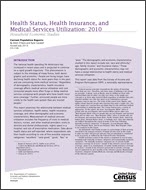Health Status, Health Insurance, and Medical Services Utilization: 2010
Health Status, Health Insurance, and Medical Services Utilization: 2010
Introduction
The national health spending for Americans has increased in recent years and is projected to continue on a rapid growth trajectory.1 This phenomenon is subject to the interplay of many forces, both demographic and economic.2 People are living longer, have declining health status for more years than in the past, and are consuming more medical services.3 Regardless of demographic characteristics, health insurance coverage affects medical service utilization and cost. Uninsured people more often forgo or delay medical services compared with people who have health insurance coverage.4 Further, uninsured people are more costly to the health care system than are insured people.5
This report examines the relationship between medical services utilization, health status, health insurance coverage, and other demographic and economic characteristics. Measurement of medical services utilization includes the frequency of visits to medical doctors, nurses, and other medical providers; visits to dentists and dental professionals; nights spent in a hospital; and use of prescription medication. Data about health status are self-reported, where respondents rate their health according to one of five possible response categories: “excellent,” “very good,” “good,” “fair,” or “poor.” The demographic and economic characteristics studied in this report include sex, race and ethnicity,6 age, family income,7 and insurance status.8 These demographic and economic characteristics may not have a causal relationship to health status and medical services utilization.
This report uses data from the Survey of Income and Program Participation (SIPP), a nationally representative longitudinal survey of the civilian noninstitutionalized U.S. population. The SIPP includes a core set of questions and topical modules. In the core, respondents are asked a variety of questions on their health insurance coverage, income, and demographic characteristics. In addition to the core, this report focuses on a topical module on medical expenses and utilization of health care. The data come from the 2001, 2004, and 2008 SIPP panels, covering the years 2001, 2002, 2003, 2004, 2005, 2009, and 2010. Most of this report’s data were collected from September through December 2010 during the seventh interview of the 2008 SIPP.9 For more information on the SIPP, see the Source of the Data section at the end of this report.10
_______________
1 Board of Trustees (2011), Truffer et al. (2010).
2 Centers for Medicare and Medicaid Services (2011), Elmendorf (2011).
3 Elmendorf (2011).
4 Sabik and Dahman (2012).
5 Chen et al. (2011).
6 Federal surveys now give respondents the option of reporting more than one race. Therefore, two basic ways of defining a race group are possible. A group, such as Blacks, may be defined as those who reported Black and no other race (the race-alone or the single-race concept) or as those who reported Black regardless of whether they also reported another race (the race-alone-or-in-combination concept). Hispanics may be any race. The body of this report (text, figures, and tables) shows data for people who reported they were a single race. Use of the single-race concept does not imply that it is the preferred method of presenting or analyzing data. The Census Bureau uses a variety of approaches. In this report, the term “non-Hispanic White” refers to people who are not Hispanic and reported White and no other race. “Non-Hispanic Black” refers to people who are not Hispanic and reported Black and no other race. “Non-Hispanic Other” refers to people who are not Hispanic and reported Asian alone, Pacific Islander alone, American Indian alone, Alaskan Native alone, or multiple races. Race and ethnicity are defined throughout the report in terms of the four following mutually exclusive categories: (1) Hispanic, (2) non-Hispanic White, (3) non-Hispanic Black, and 4) non-Hispanic Other. Non-Hispanic Other is not analyzed in this report.
7 An individual’s total family income as a percentage of their poverty threshold is the primary measure of family income used in this study. A value less than 100 percent indicates that an individual is considered to be in poverty, as defined by the Federal Poverty Thresholds.
8 Health insurance status in this report is examined in several ways, including both mutually exclusive categories and nonmutually exclusive categories. The mutually exclusive categories are (1) private health insurance coverage for at least 1 month of the reference period (private coverage, alone or in combination), (2) public health insurance coverage for at least 1 month of the reference period but no private coverage, and (3) uninsured for all 4 months in the reference period. Nonmutually exclusive categories include Medicare coverage and Medicaid coverage of the reference period.
9 To supplement the 2008 SIPP Panel data, estimates presented in the figures of this report are taken from the 2004 SIPP Panel (waves 3 and 6) and 2001 SIPP Panel (waves 3, 6, and 9).
10 The estimates in this report (shown in the text, figures, and tables) are based on responses from a sample of the population and may differ from the actual values due to sampling and nonsampling error. As a result, apparent differences between the estimates for two or more groups may not be statistically significant. All comparative statements in the text have undergone statistical testing and are significant at the 90 percent confidence interval unless otherwise noted.
Tables
Others in Series
Publication
Publication
Publication





